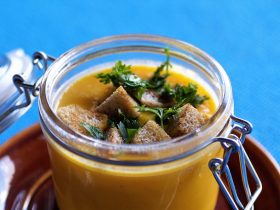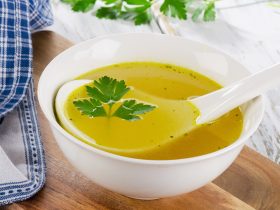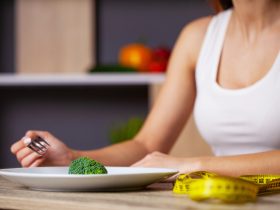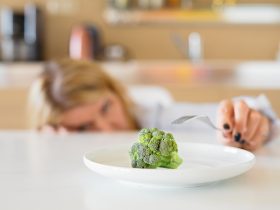The Volumetrics Diet is a dietary plan specifically designed to facilitate weight loss by focusing on the consumption of low-calorie, nutrient-rich foods. This approach aims to curb hunger by prioritizing foods with a high water content and a low-calorie density. Additionally, it promotes adopting other healthy habits, such as regular physical activity and maintaining a food journal.
However, you might be contemplating whether this diet is suitable for your weight loss journey. This article offers a comprehensive assessment of the Volumetrics Diet, delving into its effectiveness as a means of shedding pounds.
Understanding the Volumetrics Diet
The Volumetrics Diet’s fundamental premise is to help you feel satiated while reducing your overall calorie intake.
Founded on the work of nutrition scientist Dr. Barbara Rolls, this diet is detailed in her book, which provides extensive guidance, recipes, and instructions for calculating the calorie density of your preferred foods.
Essentially, the Volumetrics Diet advocates for the consumption of nutrient-dense foods that are both low in calories and high in water content, such as fruits, vegetables, and soups. Conversely, it limits the intake of calorie-dense foods like cookies, candies, nuts, seeds, and oils.
Dr. Rolls contends that these dietary restrictions contribute to prolonged feelings of fullness, reduced calorie consumption, and weight loss.
Distinguishing itself from many other diets, the Volumetrics Diet emphasizes the development of healthy eating habits. It should be approached as a long-term lifestyle adjustment rather than a short-term, quick fix.
How It Works
The Volumetrics Diet classifies foods into four distinct categories, determined by their calorie density:
Category 1 (Very Low-Calorie Density): Foods with a calorie density of less than 0.6.
Category 2 (Low Calorie Density): Foods with a calorie density ranging from 0.6 to 1.5.
Category 3 (Medium Calorie Density): Foods with a calorie density between 1.6 and 3.9.
Category 4 (High-Calorie Density): Foods with a calorie density ranging from 4.0 to 9.0.
Dr. Rolls’s book offers comprehensive guidance on calculating calorie density. Generally, this calculation involves dividing the number of calories in a specific serving size by its weight in grams, resulting in a figure within the 0 to 9 range.
For instance, foods abundant in water content, like broccoli, typically fall into the very low-calorie density category, while desserts and processed items such as dark chocolate tend to have a high-calorie density.
In adherence to the Volumetrics Diet, a typical meal should primarily consist of foods from Category 1, supplemented by items from Category 2 to ensure a well-balanced plate. Modest quantities of Category 3 foods are acceptable, while Category 4 items should be consumed sparingly.
The standard Volumetrics Diet meal plan provides an estimated 1,400 daily calories. Still, it can be customized to align with your specific calorie objectives by incorporating additional snacks or adjusting portion sizes.
Notably, the Volumetrics Diet imposes no complete prohibitions on specific foods. It allows for including high-calorie-density foods by modifying portions and balancing them with other meals.
Furthermore, the diet strongly encourages engaging in at least 30 to 60 minutes of daily physical activity.
Keeping a journal to record your physical activity and dietary intake is advisable. This practice serves as a tool to track progress and identify areas that may require improvement.
Effectiveness for Weight Loss
Does the Volumetrics Diet deliver on its weight loss promises? Although limited studies have focused solely on the Volumetrics Diet, existing research suggests that its core principles can facilitate weight loss.
Promotes Low-Calorie Intake
The emphasis on selecting foods with low-calorie density proves to be particularly effective. With their substantial volume and modest calorie content, these foods permit generous servings without significantly increasing overall calorie intake.
Significantly, a review encompassing 13 studies involving 3,628 individuals established a clear connection between foods with lower calorie density and increased weight loss. In parallel, an extensive 8-year study conducted among over 50,000 women linked high-calorie-density foods to noticeable weight gain.
Furthermore, opting for foods with low-calorie density may act as a deterrent against cravings and diminished appetite, potentially enhancing weight loss efforts.
An insightful 12-week study conducted with 96 women with excess weight and obesity discovered that meals with a lower calorie density reduced cravings, heightened sensations of fullness, and a decreased sense of hunger.
In an earlier study involving 39 women, participants consumed a staggering 56% more calories when presented with a larger portion of a high-calorie-density meal than a smaller, low-calorie-density meal.
Encourages Regular Exercise
Another integral aspect of the Volumetrics Diet is encouraging regular physical activity.
The diet advises individuals to aim for a minimum of 30 to 60 minutes of exercise each day. This regimen can amplify weight loss and the reduction of body fat by elevating your daily energy expenditure, effectively increasing the number of calories burned throughout the day.
Additional Health Benefits
Beyond weight loss, the Volumetrics Diet may offer various other health advantages.
Potential Improvement in Diet Quality
By promoting the consumption of nutritious foods that are both low in calories and high in essential nutrients like fiber, vitamins, and minerals, the Volumetrics Diet can enhance your overall diet quality. This may also serve as a protective measure against nutritional deficiencies.
Moreover, certain research suggests that diets characterized by low-calorie density are correlated with an enhancement in diet quality.
Restriction of Processed Foods
While the Volumetrics Diet doesn’t impose an outright ban on any foods, it does encourage the limitation of processed foods as part of its regimen. This recommendation is rooted in the fact that most processed foods tend to have a high calorie density and should therefore be consumed sparingly within this dietary framework.
As a rule, processed foods are deficient in vital nutrients such as fiber, protein, vitamins, and minerals and are typically laden with excess calories, fat, sugar, and sodium.
Furthermore, various studies have established a direct link between regular consumption of processed foods and an elevated risk of conditions like cancer, heart disease, and premature mortality.
Flexibility and Long-Term Sustainability
In stark contrast to many fad diets, the Volumetrics Diet is intended to be a sustained, long-term lifestyle modification.
It encourages individuals to become more mindful of their eating habits and food choices, empowering them to make healthier dietary decisions by prioritizing foods with a lower calorie density, such as fruits and vegetables.
Additionally, as no foods are off-limits within this diet’s framework, individuals can enjoy their favorite dishes by making thoughtful modifications and adjustments to their eating patterns.
This adaptability renders the Volumetrics Diet an appealing option for those searching for a flexible and sustainable dietary plan to adhere to over the long haul.
Potential Drawbacks
While the Volumetrics Diet has its merits, there are several aspects that individuals should be mindful of:
Time-Intensive with Limited Online Resources
One notable challenge with the Volumetrics Diet is the considerable time and effort it demands, potentially rendering it impractical for certain individuals.
In addition to sourcing recipes, meal planning, and calculating calorie density, the diet expects you to prepare your meals and snacks at home predominantly. This level of restriction might prove challenging for those leading busy lives, dealing with cramped kitchen spaces, or needing more access to fresh produce.
Furthermore, although some support groups and recipes are accessible, online applications and resources dedicated to the diet are relatively sparse. In some cases, you may purchase Dr. Rolls’s book to effectively calculate your meal’s calorie density and track your food intake.
Restriction of Healthy Fats
Another noteworthy aspect of the diet is its limitation on certain foods rich in healthy fats, including nuts, seeds, and oils. These particular foods are renowned for providing monounsaturated and polyunsaturated fats, which possess the potential to mitigate inflammation and offer protection against chronic conditions such as heart disease.
It’s worth noting that various nutritious dietary patterns, such as the Mediterranean diet, actively encourage the consumption of these healthy fat sources.
Excessive Focus on Caloric Content
The Volumetrics Diet’s heavy reliance on calorie density can lead to limitations on high-calorie foods. Consequently, nutritious and calorie-dense foods, such as avocados, nut butter, and whole eggs, may be restricted. Meanwhile, processed, low-calorie foods like fat-free salad dressing and diet ice cream may be permitted due to their low-calorie density.
It’s essential to recognize that low-calorie foods often compensate for their reduced caloric content by incorporating added sugar and other less-than-healthy ingredients to enhance flavor. Simply put, a low calorie count is not necessarily a healthy food choice.
Food Selection and Categories
Rather than outright banning specific foods, the Volumetrics Diet categorizes them based on their calorie density. This categorization system guides your food choices while allowing for diverse options.
Category 1: Very Low Calorie Density
Foods in this category have an extremely low calorie density and should constitute the bulk of your dietary intake. They encompass:
Fruits: Apples, oranges, pears, peaches, bananas, berries, and grapefruit.
Non-starchy vegetables: Broccoli, cauliflower, carrots, tomatoes, zucchini, and kale.
Soups: Broth-based soups such as vegetable soup, chicken soup, minestrone, and lentil soup.
Nonfat dairy: Skim milk and nonfat yogurt.
Beverages: Water, black coffee, and unsweetened tea.
Category 2: Low Calorie Density
Foods in the second category possess a low energy density and can be enjoyed in moderation. This category includes:
Whole grains: Quinoa, couscous, farro, buckwheat, barley, and brown rice.
Legumes: Chickpeas, lentils, black beans, and kidney beans.
Starchy vegetables: Potatoes, corn, peas, squash, and parsnips.
Lean proteins: Skinless poultry, white fish, and lean cuts of beef or pork.
Category 3: Medium Calorie Density
Foods in this category are categorized as having a medium calorie density. While they are permissible, exercising caution with serving sizes is important. These foods include:
Meat: Fatty fish, poultry with the skin, and high-fat cuts of pork and beef.
Refined carbs: White bread, white rice, crackers, and white pasta.
Full-fat dairy: Whole milk, full-fat yogurt, ice cream, and cheese.
Category 4: High Calorie Density
Foods in the final category are classified as high-energy density. These foods pack many calories per serving and should be consumed sparingly. The category encompasses:
Nuts: Almonds, walnuts, macadamia nuts, pecans, and pistachios.
Seeds: Chia seeds, sesame seeds, hemp seeds, and flax seeds.
Oils: Butter, vegetable oil, olive oil, margarine, and lard.
Processed foods: Cookies, candies, chips, pretzels, and fast food.
This classification system allows for flexibility in food selection while guiding individuals toward choices that align with the principles of calorie density.
Sample 3-Day Meal Plan
Following the Volumetrics Diet, you’ll consume three main meals daily, along with two to three snacks. Below is a sample 3-day menu to give you an idea of what your meals could look like:
Day 1
Breakfast: Start your day with a serving of oatmeal topped with fresh fruit and accompany it with a glass of skim milk.
Snack: Mid-morning, enjoy a healthy snack of crisp carrots with a side of hummus.
Lunch: For lunch, savor grilled chicken paired with quinoa and a side of asparagus.
Snack: In the afternoon, treat yourself to some sliced apples paired with a light string cheese.
Dinner: Round off your day with a delectable meal of baked cod served with spiced vegetable couscous.
Day 2
Breakfast: Kickstart your morning with a bowl of nonfat yogurt topped with fresh strawberries and blueberries.
Snack: As a mid-morning snack, relish a hard-boiled egg accompanied by slices of juicy tomatoes.
Lunch: Noon brings a hearty serving of turkey chili featuring kidney beans and a medley of vegetables.
Snack: In the afternoon, savor a refreshing fruit salad comprised of melon, kiwi, and strawberries.
Dinner: End your day with zucchini boats generously stuffed with ground beef, tomatoes, bell peppers, and a luscious marinara sauce.
Day 3
Breakfast: Start your day anew with scrambled eggs enhanced by the flavors of mushrooms, tomatoes, and onions, accompanied by a slice of whole wheat toast.
Snack: For a mid-morning snack, blend up a nourishing smoothie using skim milk, a ripe banana, and a handful of assorted berries.
Lunch: Noon brings comforting chicken noodle soup complemented by a side salad.
Snack: In the afternoon, munch on air-popped popcorn for a satisfying and crunchy treat.
Dinner: Conclude your day with a delightful serving of whole grain pasta paired with succulent turkey meatballs and sautéed vegetables.
This sample meal plan showcases how the Volumetrics Diet encourages a balanced and nutritious approach to eating, emphasizing foods that are filling and nourishing.
In Conclusion
The Volumetrics Diet strongly emphasizes selecting foods that are low in calorie density but high in volume, ultimately aiding in weight loss by promoting a sense of fullness while curbing hunger and cravings.
Furthermore, it can enhance the overall quality of your diet by encouraging the consumption of nutrient-rich foods such as fruits and vegetables.
However, it’s essential to note that the Volumetrics Diet demands significant time and effort. Additionally, it imposes restrictions on some healthy foods and offers limited online resources, which could render it less suitable for certain individuals.















Find Us on Socials